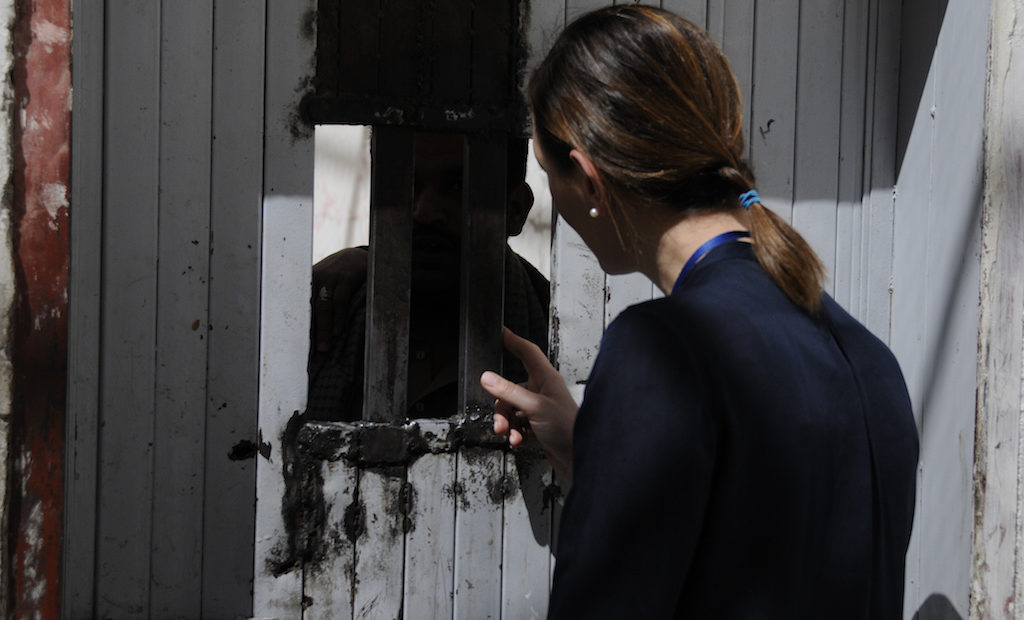Realities of detention in contemporary armed conflicts
Regardless of the actor depriving persons of their liberty or of where those detained are held, all too often the ICRC finds that detainees are subject to extra-judicial killing, enforced disappearance or torture and other forms of ill-treatment. We also frequently observe that conditions of detention are inadequate—lacking in basics such as adequate food, water, clothing and bedding, accommodation, hygienic installations or health care. Detainees are often not properly registered or are deprived of meaningful contact with the outside world. Our delegates observe that especially in conflict situations, persons are detained arbitrarily—based on an unclear or non-existing legal framework, without effective review of their detention—and, at times, held in secret or unofficial places of detention.
In our dialogue with the various detaining authorities certain legal themes often arise. Such recurring issues include the treatment of detainees, their conditions of detention, grounds and procedures for their detention, the particular challenges of detention by multinational forces, and the question of how non-State armed groups can comply with relevant international law. The more we work to assist with the humanitarian consequences of migratory movements, the more we also engage on issues of migration-related detention.
IHL protecting detainees in NIAC
In our interaction with detaining authorities, international and national law provide us with the framework for our advice and interventions. In our experience, on a number of key issues the law provides detaining authorities with adequate provisions on how to protect the fundamental rights and dignity of detainees. For example, there is no question that torture and other forms of ill-treatment—including sexual violence or enforced disappearances—are absolutely prohibited in all circumstances. For these basic prohibitions, it is primarily ignorance of the law or failure to implement that leads to inhumane treatment of detainees. In other cases—especially with regard to conditions of detention—a lack of infrastructure and resources often impede the establishment of an adequate detention regime. In this regard, we are conscious that implementing basic legal standards for detainees is particularly challenging during the early stages of detention, especially when detainees are captured during hostilities.
On other issues, the ICRC is of the view that the scarcity of legal norms—especially in non-international armed conflicts (NIACs)—constitutes an obstacle to safeguarding the life, health and dignity of those who have been detained. Indeed, while the Geneva Conventions contain several hundred rules regulating deprivation of liberty in relation to international armed conflicts in virtually all its aspects, no comparably detailed legal regime applies in non-international armed conflicts. This gap is particularly worrying with regard to issues such as notification of capture, grounds and procedures for internment and rules on detainee transfers.
Some remedies: Moving forward on the legal protection of detainees
In order to assist all parties to armed conflicts in the faithful application of IHL, the ICRC has an interest and mandate to work for the understanding and dissemination of this body of law and to prepare for possible developments that may occur. In recent years, the ICRC has done important work on the protection of detainees, both with regard to the protection of prisoners of war and with regard to detention in relation to NIACs.
Update of commentary on the Third Geneva Convention
First, many of you will be aware that the ICRC is currently updating its commentaries on the four Geneva Conventions and on the Additional Protocols. At the moment, our team, supported by a group of external contributors and a geographically representative group of expert peer reviewers, is working on an update to our commentary on the Third Geneva Convention relative to the Treatment of Prisoners of War (GC III). An important strength of the updated commentaries is that they take into account the practice and developments in international law that have taken place in the almost 70 years since the adoption of the Conventions. The commentary on GCIII will provide up-to-date definitions of key concepts on the treatment of detainees, like humane treatment, decent conditions of detention, special protection of women, family contacts and avoiding prisoners going missing. We write these commentaries as tools for practitioners in order to enhance the protection of current and future prisoners of war. We are very happy that once published, all updated commentaries are freely available on our website (see GC I and GC II).
Strengthening IHL protecting detainees in relation to NIACs
We have also been working with States since 2011 to strengthen IHL that protects persons deprived of their liberty in relation to non-international armed conflicts. NIACs are the vast majority of today’s armed conflicts and pose important humanitarian challenges, yet, as mentioned, most IHL rules govern international, no non-international, armed conflicts. During the various consultations and meetings we have organized, States have largely confirmed the ICRC’s concern that IHL protecting detainees in NIAC needs strengthening in four main areas:
- Conditions of detention;
- The protection of vulnerable groups;
- Grounds and procedures for internment; and
- Detainee transfers.
In light of the important need to address this situation, in late 2015 States agreed to work collectively on concrete and implementable outcomes to strengthen IHL protections for detainees. However, until today it has not been possible to agree on how to work collectively towards such outcomes. While the ICRC sincerely regrets this situation, we continue to reflect on what steps can be taken, from a practical point of view, to strengthen IHL protecting detainees in NIACs, and we continue to work on detainee protection within our mandate. For example, in July the ICRC convened a meeting among government experts on how States can ensure humane treatment and conditions of detention during the early stages of detention close to hostilities and during short-term detention. The meeting facilitated an exchange among military practitioners on challenges that arise in various detention operations and how they can be overcome.
The ICRC’s work to improve prison conditions
In addition to our work to strengthen detainee protection during armed conflict, the ICRC has also taken very concrete steps to contribute to better conditions of detainees for all persons who are held in prisons. Building on its extensive experience in visiting prisons and engaging with prison authorities, the ICRC has just released a set of guiding principles on prison planning and design. The ICRC has also cooperated with leading academics to update a Handbook for Prison Staff on a ‘Human Rights Approach to Prison Management’. These are very concrete tools that I can warmly recommend to anyone involved in prison planning and management.
***
Not long ago, the ICRC President, Peter Maurer, asked me to sit down and have a conversation with him about his recent experiences in detention work and where he sees the greatest challenges. I will conclude this blog post by taking up one point that Peter stressed in our conversation, which I fully support. As the ICRC, to ensure respect for applicable international law—in particular IHL—we need to develop many ways to clarify the law in order to provide concrete guidance to all parties to armed conflicts on how to ensure humane treatment of detainees, adequate conditions of detention and relevant procedural safeguards and judicial guarantees. Indeed, in order to address the various humanitarian challenges we see in our detention operations—as lawyers, policy makers and humanitarians—we need to identify effective ways to clarify the law and to translate it into strategies that have the envisaged effects on the ground.
More on detention and the ICRC
- Strengthening IHL protecting persons deprived of their liberty: Main aspects of the consultations and discussions since 2011, Tilman Rodenhäuser, International Review of the Red Cross,February 2018
- ICRC Opinion Paper: Internment in armed conflict: Basic rules and challenges, November 2015
- The protective scope of Common Article 3: more than meets the eye, Jelena Pejic, International Review of the Red Cross, 2011
- Procedural principles and safeguards for internment/ administrative detention in armed conflict and other situations of violence, Jelena Pejic, International Review of the Red Cross, 2005
- Information and documents on the State consultation process: Strengthening IHL protecting persons deprived of their liberty in relation to armed conflict
More on detention, migration and IHL
- Blog post: IHL & the protection of migrants caught in armed conflict, Helen Obregón Gieseken & Éloïse Ouellet-Décoste, June 4, 2018
- Blog post: The principle of non-refoulement in the migration context: 5 key points, Tilman Rodenhäuser, March 30, 2018
More on detention realities
- International Review of the Red Cross issue on detention: Detention: addressing the human cost






Comments